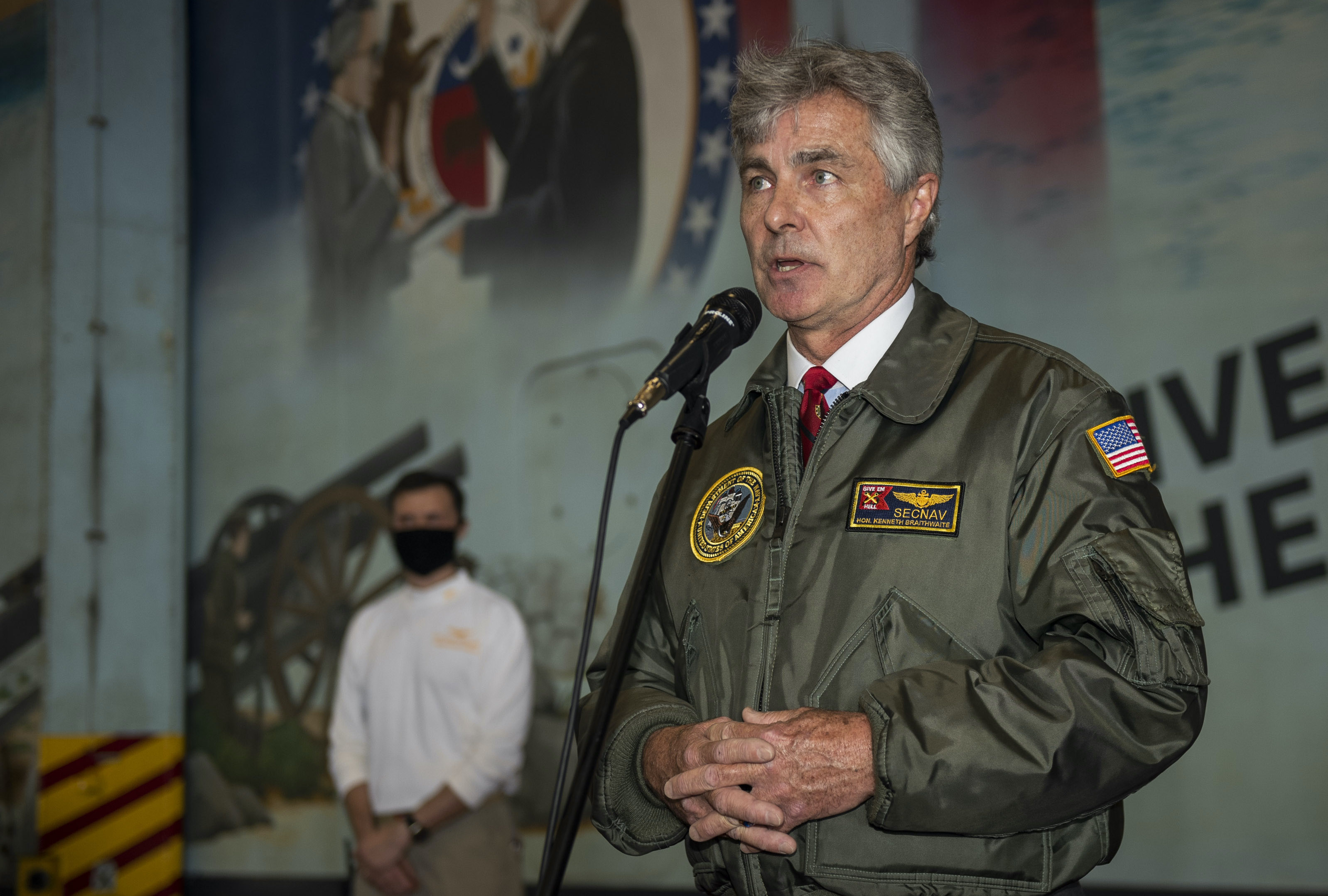
THE PENTAGON – Just eight workdays into the job, Secretary of the Navy Kenneth Braithwaite planned to spend his first of many long nights at the Pentagon, in the latest effort to solve the Navy’s biggest problem: how to build a fleet to compete with Russia and China without the money the service saw during its Cold War buildup.
Now the fourth person to sit at the SECNAV desk since the Navy and Marine Corps began drafting their latest ideas for what the fleet of tomorrow ought to look like – currently sitting on the defense secretary’s desk under review – Braithwaite finds himself with little time to digest the services’ near-term and long-term plans and weigh in with his own priorities and vision.
In a matter of weeks, he will owe the defense secretary his input on both the Fiscal Year 2022 budget request and the so-called Integrated Naval Force Structure Assessment (INFSA) that looks several years down the line at what the Navy could be.
“Tonight we start the process of going through the entire Navy budget. I want to understand and own every aspect of it. So we are going to work late into the night from now until probably the end of the month or even into early July, because I am responsible to deliver a budget that the secretary has asked me to deliver that is reflective of what the needs of the Navy are, predicated on this new era of great power competition and what our pacing threat is,” Braithwaite told USNI News on June 10 from his Pentagon office, in his first media interview since taking over the job.
“I have asked the leadership in the Navy to join with me and kind of reimagine the Navy from the ground up. If we had a clean sheet of paper, what would the Navy look like today? What could it look like tomorrow? Not only from what ships are part of the fleet structure, what aircraft are in the air or submarines under the seas, but what’s the laydown of personnel? And do we have the command and control systems correct? Are they reflective of a more agile and flexible force, or are they indicative of the last war we fought and a Cold War legacy? I really believe that we are at a turning point in the history of the Navy on what the future force structure will be, and we need to make sure that that meets the emerging threat.”
Whereas former Acting Secretary Thomas Modly had embarked on an effort to squeeze $40 billion in savings across the next five years to help pay for the increase in the Navy’s shipbuilding budget, Braithwaite said of his new effort, “we’re going to do a deeper dive. I’d like to see actually more savings.”
Braithwaite comes into this job with a dual set of perspectives: a career naval officer and 1984 graduate of the U.S. Naval Academy, he spent 10 years on active duty and then had what he calls an active stint in the reserves during his next 21 years in uniform. When not in uniform, he spent his civilian career in business operations and lobbying. This combination of experiences is shaping his view of how to tackle the Navy’s budget, in a time when the service is being asked to grow significantly, readiness has proven to be a precious resource, and budgets are expected to remain flat or decline.
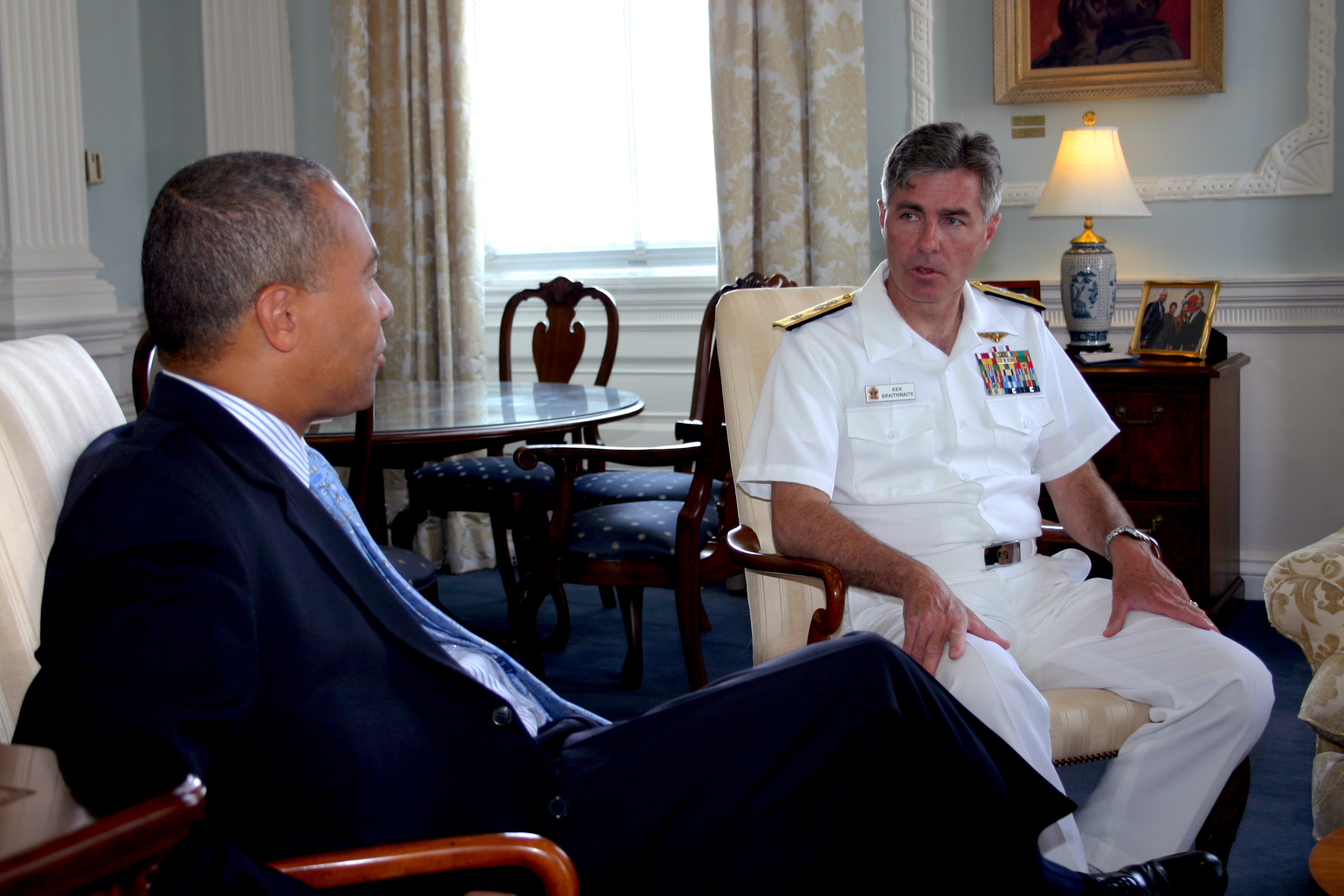
“Rarely does the Department of the Navy have to worry about going bankrupt. But the private sector, you always have to have that in the back of your mind. So you’re constantly working to become more effective, more efficient; you’re looking for return on investment and economies of scale. So I think if anything from the private sector, we need to begin to bring those lessons into the department, because – as it was in the Navy that I was a part of as a young lieutenant when we were building towards 600 ships and it was a pretty heady time – today there are too many pressures upon us to come at it with any less of a mindset than we have a responsibility, a fiscal stewardship, if you will, to the taxpayers of America. Because resources aren’t unlimited, this nation is in massive debt, so we need to ensure that we provide a capable force, a force that is able to deter aggression, but we have to do that with a mind to the bottom line and recognize that that’s probably one of our greatest responsibilities. So the American taxpayer, as I look at it, is my shareholder, and I have to be sensitive to what the return on investment of the dollars that they give to us is all about.”
During his confirmation hearing before the Senate Armed Services Committee, he joined others who’ve said Navy’s currently stated requirement of 355 ships – which the service still hasn’t proven it can build and maintain with current funding levels – still may not be enough to support the Navy’s global commitments under the National Defense Strategy.
“I’m a navalist, unabashed, unapologetic. As you heard during my (Senate confirmation) hearing, is 355 the right number? Maybe it needs to be bigger than that. And I want to begin to entertain that narrative and inject that into the national discussion,” he said.
“When we think about the emerging competition around the globe, power projection and what the Navy and Marine Corps team bring is extremely important to how we deter any aggression.”
He also threw his support behind the new FFG(X) frigate and Columbia-class ballistic missile submarine programs, the ongoing Arleigh Burke-class destroyer program and the potential of unmanned vessels as all having a place in that future fleet. He was especially interested in lightly manned and unmanned ships, saying that in Norway – where he spent the last two years as ambassador – unmanned vessels were already helping ferry people and ships in and around the fjords.
“There’s some promise there, and we need to be kind of Jules Verne-ish looking as we look to the future and imagine what could be.”
In broad strokes, the secretary said that “I believe that we should invest in our sailors and our Marines and give them the tools they need to get their jobs done, help them be properly educated so again they can perform at a higher level, and we need to invest in the platforms that they’re going to operate so that they have the cutting-edge technology in the systems we give them to operate.”
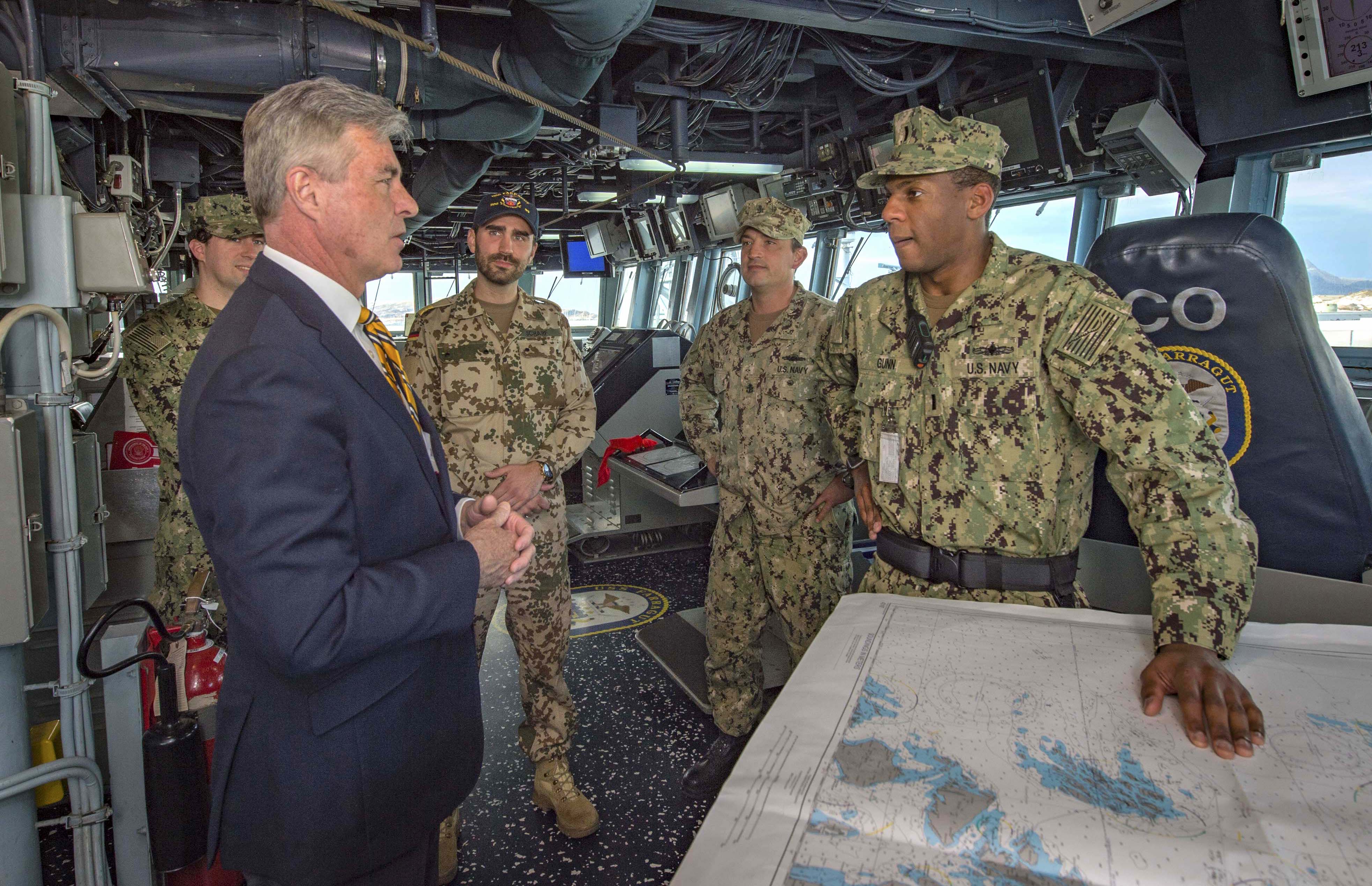
Braithwaite isn’t the first to try to grow and modernize and find savings to do so in the Navy budget. Richard V. Spencer came into the job in August 2017 with a reputation for making bold business moves and promised acquisition reform through more business-like transparency and accountability. Upon his departure, Modly called for a radical change in how the Navy did business, including rethinking things as fundamental as what an aircraft carrier ought to look like. Though Modly got as far as putting a plan on paper to reach 355 by the end of the decade, it’s not clear that the Office of the Secretary of Defense was ever going to support that level of shipbuilding – hence the kickoff of the so-called Stem to Stern Review in February, in an effort to self-fund the planned shipbuilding bonanza.
Braithwaite said the timing of coming into the job is actually good, in that the FY 2022 submission is still “in its infancy,” so “I get a good chop at that.” On the longer-term planning in the INFSA, which Navy and Marine Corps uniformed leaders and Modly have already signed off on but is waiting in OSD for further review, Braithwaite said, “I’d like to think he’s been waiting for me to get here to kind of get in on that.”
“I have talked to [Defense Secretary Mark Esper] extensively about that. Part of what I just mentioned to you is the process by which we are going to look at what the current budget structure is, figure out what the fleet structure should be, and incorporate that all together. So I don’t think it will be too long before you begin to see the fruits of those labors.”
The SECNAV said he spoke to several former secretaries, including his mentor, John Lehman, to discuss the similar challenges they faced.
“I’m actually going to go deeper into the budget than any of my predecessors did, only because I want to own it. And I’m coming at this, even though I’m a career naval officer, I’m coming at it with a mindset of a private sector executive and wanting to know where some of the inefficiencies are,” Braithwaite said.
“At the end of the day, that’s the secretary of the Navy’s desk right there, and it’s my responsibility to deliver a budget that is most effective, is most efficient, and creates those economies that we’re going to fight for.”
“We’re stopping things; we’re reviewing everything from the bottom up and from the top down; we’re going to assess it: is it adding value, or are we doing it just because – the worst seven words in the English language – that’s the way we’ve always done it? And there’s a lot of that rooted deep within the department. This building has had a history of that.”
Navy Culture and Leadership
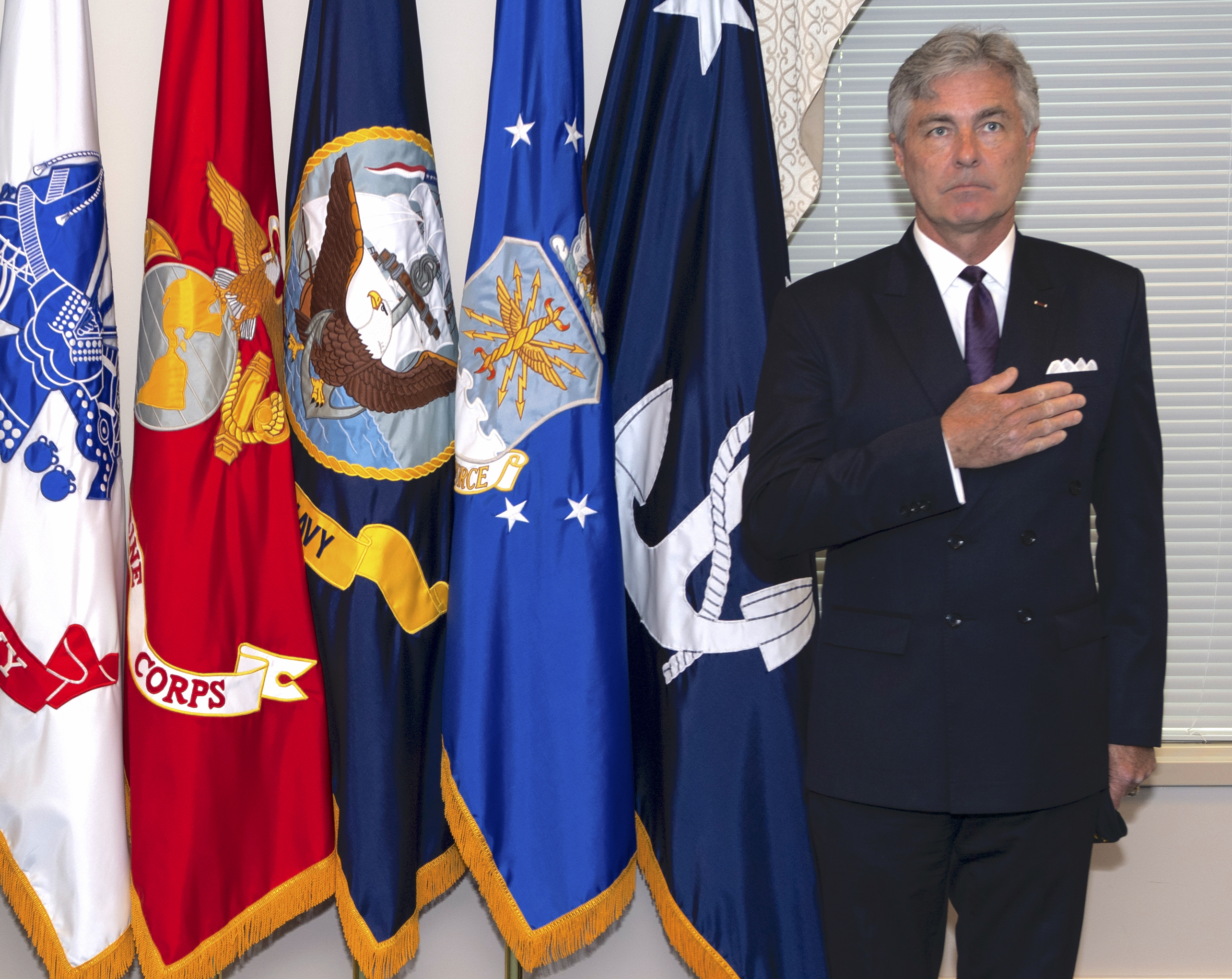
Braithwaite turned heads during his Senate confirmation hearing when he claimed that Navy culture had been tarnished through a series of missteps, dating back to his time in the Navy in the late 1980s and early 1990s but also continuing in last year’s the failed prosecution of former SEAL Eddie Gallagher and the fallout from the COVID-19 outbreak on carrier USS Theodore Roosevelt (CVN-71).
Braithwaite told USNI News that his comments were directed at civilian leadership, not sailors or Marines.
“Some of the decisions made over the last few years have impacted the service in a way that has not reflected as greatly upon those who are in uniform,” he said.
Contributing to that leadership and culture challenge has been the rate of turnover during the Trump administration. Whereas the Navy previously had been led by Ray Mabus for the whole eight years of the Obama administration, the Navy was since led by Sean Stackley as acting secretary from January to August 2017; Spencer from August 2017 until November 2019; Modly as acting secretary from November 2019 until April; and then Army Undersecretary James McPherson serving as acting Navy secretary from April until Braithwaite’s May 29 swearing-in ceremony.
“Culture, I think, is probably the most important element of any organization,” Braithwaite said, and he sees it as his job to personally set the tone for the rest of the fleet and the Department of the Navy.
What is the culture he wants to promote? Acts of, and recognition of, “service above self,” he said repeatedly during the interview.
Among the first things Braithwaite did after being sworn in as secretary was fly out to USS Harry S. Truman (CVN-75), which has been loitering off the coast of Virginia since mid-April to keep the crew safe from the coronavirus, in case the carrier was to be called upon to act before another carrier was certified and ready to go.
“I decided to award them all the Meritorious Unit Commendation, because I feel that words are one thing, but you need to be able to back that up with actions. And as I mentioned to them on the hangar deck, for the rest of their lives I want them to look down upon their uniform and to see the ribbon that they earned and have that be a reminder and a recognition of the service above self that they gave to our country and the sacrifices they made for our security,” he said. “That’s the kind of stuff I hope to be able to recognize our sailors and Marines for all the great work that they do every day.”
Braithwaite said his focus on highlighting service and instilling pride in the Navy’s long heritage actually stems from another tumultuous time: he said that as a young officer, the Navy was facing challenges such as the 1991 Tailhook scandal. He said he found it helpful when leadership at the time reminded sailors of all those that had come before them and footstomped the message that everyone needed to be worthy of those that came before and those that would come after. Following a string of controversies and mishaps in recent years, Braithwaite said he wants to do the same for today’s sailors.
“Today, especially the leaders need to recognize the responsibility that they have to those that have not only gone before, but to ensure that the sailors of the future are going to be attracted to be part of the service they hold above themselves. I believe in something called service above self – I think that in this world that we’re in today that we need to remember that being part of something that we hold in high regards sets us apart from the norm, and there’s a sense of pride in service.”
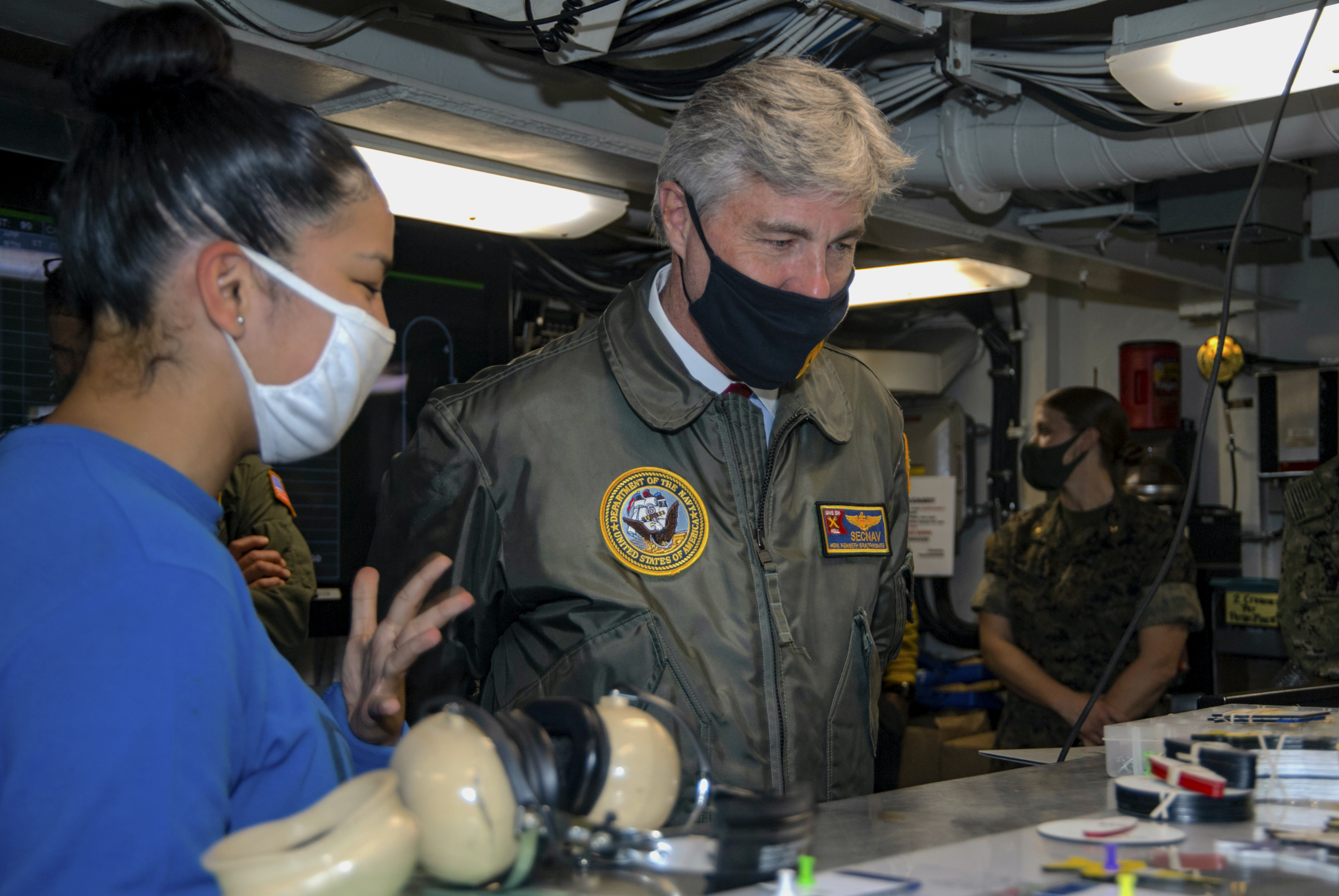
Braithwaite also spoke to the need of the service to not only talk about its history, but to talk publicly about where the Navy is headed. Amid concerns from lawmakers, think tanks, media and more that the Navy has become less transparent about its strategy and its plans for the future force, Braithwaite told USNI News that “I do believe we need to tell the Navy’s story better, both externally to the American people and, again, to the taxpayers, but also internally. It goes back to the culture piece, and I want to share that, so that people know who are serving today where their Navy is heading, what our intentions are … so that they can embrace that and have a sense of pride and understanding.”
He said he’s already taken steps to be more inclusive and bring in more opinions to help shape that direction – including bringing the master chief petty officer of the Navy into weekly leadership meetings. Braithwaite said he was surprised to hear that MCPON wasn’t already included in these meetings, and he said he learned early in his naval career that some of the best leadership comes from the chiefs. He added it was important that sailors and Marines at all levels feel invested in the Navy, its mission today and its direction for tomorrow: “top to bottom, all of us are one team, one fight, one mission.”
Of course, for all the changes Braithwaite hopes to effect, it’s hard to ignore that an election will take place in just shy of five months. Asked how that influences his goals and plans for the job, Braithwaite made clear he never hesitated when he was asked to take on this job.
“For me, whether I get to do this job for a few months at a critical time in the history of the Navy, or I get to do it beyond that, this is a solemn duty and I feel an obligation of all that the department has given me, of all that the Navy has taught me over the years. If I can give even a little bit back to help us at a really difficult time, I didn’t have a choice. This is what I had to do. This was my duty to come and serve the men and women of the Navy. So there was no hesitancy,” he said.
“I am beyond humbled and privileged to get to be the secretary of the Navy, and I want my tenure here to be meaningful.”





